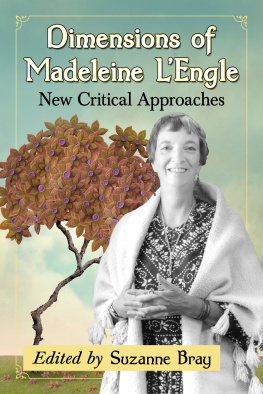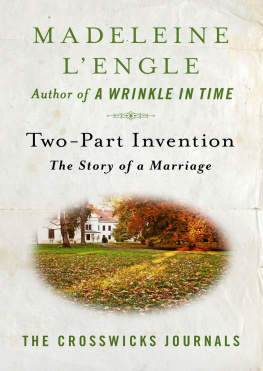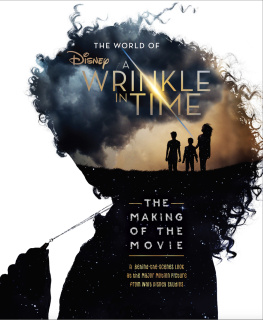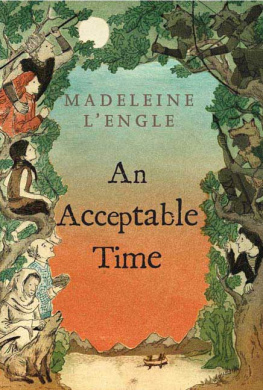
Dimensions of Madeleine LEngle
New Critical Approaches
Edited by SUZANNE BRAY

McFarland & Company, Inc., Publishers
Jefferson, North Carolina
LIBRARY OF CONGRESS CATALOGUING DATA ARE AVAILABLE
BRITISH LIBRARY CATALOGUING DATA ARE AVAILABLE
e-ISBN: 978-1-4766-2798-4
2017 Suzanne Bray. All rights reserved
No part of this book may be reproduced or transmitted in any form or by any means, electronic or mechanical, including photocopying or recording, or by any information storage and retrieval system, without permission in writing from the publisher.
Front cover image of Madeleine LEngle (Madeleine LEngle Papers [SC-3], Special Collections, Buswell Library, Wheaton, Illinois); background image of tree in fall 2017 ValentinaPhotos/iStock
McFarland & Company, Inc., Publishers
Box 611, Jefferson, North Carolina 28640
www.mcfarlandpub.com
Preface
Madeleine LEngle died on September 6, 2007, after a long and successful career as a writer. From 1963, when her best-known novel, A Wrinkle in Time, won the Newbery Medal, LEngle was in the public eye, everything she wrote sold well and she was in constant demand to give speeches, write forewords, and to advise and encourage younger writers. However, in spite of her overwhelming success with the reading public, LEngle has been largely ignored by academia. Although several biographies have been published, mostly aimed at the young adult reader, as well as many testimonies of her influence as a teacher and spiritual director, very little real literary criticism has been done on any of LEngles work except on the first three books of the time quintet, and practically no serious articles have been published on any of her adult fiction. At the present moment, there exists very little academic writing on her religious works, poems or short stories, and there has been little analysis of her theories of writing. On the other hand, LEngles works have been strongly criticized by members of the public and, in some cases, banned. It has been said, for example, of A Wrinkle in Time that some people think its too Christian, while others think it is not Christian enough (Baldarasso). The novel has also been claimed to promote New Age ideology, Communist sympathies and even Satanism.
This book is an attempt to stimulate intellectual discussion about all of LEngles work and to show that the vast majority of her writings, not only the best-known childrens books, are worthy of academic study. The first essay suggests, using Madeleine LEngles life and geographical attachments as guidelines, different aspects of her work which would repay further study. Critical essays on specific books or stories by LEngle, by scholars from both sides of the Atlantic, provides a more analytical approach to her writings. Finally, a detailed bibliography provides ideas for further reading.
Some of the essays analyze works that have never been studied in depth before. Grald Prher, for example, examines one of LEngles early short stories that throws light on her always ambiguous relationship with the American South, while Emily Louise Zimbrick Rogers includes an examination of the Genesis trilogy and three other of LEngles less well-known biblical works in her highly original article. Gregory G. Pepetone also breaks new ground in his discussion of Madeleine LEngles relationship with Romanticism. Gender issues are frequently evoked in these critical essays. Anne-Frdrique Mochel-Caballero examines the way in which LEngle reverses gender stereotypes in A Wrinkle in Time, while Chantel Lavoie analyzes the authors message to male teenagers in Many Waters. Gender is also important in Carol S. Frankos study of Vickys nature and vocation in the Austin family novels and Emily Louise Zimbrick-Rogers overview of LEngles biblical midrash.
Emily Louise Zimbrick-Rogers also tackles another recurrent theme in these essays: LEngles theology. Her contribution shows LEngles approach to biblical interpretation and how her writings attempt to give a voice to voiceless characters in the narrative, while producing a more complete presentation of the character of God. Sophie Dillinger shows how much LEngles theology owes to George MacDonald, while Naomi Wood compares and contrasts the theological message in LEngles works with that of her fellow Anglican C.S. Lewis. Lastly, the study of The Other Side of the Sun as a conversion story also brings to light several of LEngles main theological themes.
If this book gets people thinking and talking about Madeleine LEngle, as well as reading and studying more of her works, the authors will have succeeded.
Selected Works
Works by Madeleine LEngle
BOOKS FOR CHILDREN
(mainly for the age group 8 to 13)
The Anti-Muffins (1980).
Dance in the Desert (1969).
Ladder of Angels: Stories from the Bible Illustrated by the Children of the World (1979).
Meet the Austins (1960).
The Other Dog (2001).
The Sphinx at Dawn (1989).
The Twenty-Four Days Before Christmas (1984).
A Wind in the Door (1973).
A Wrinkle in Time (1962).
NOVELS FOR YOUNG ADULTS
(mainly for the age group 12 to 18)
An Acceptable Time (1989).
And Both Were Young (1949)principally for girls.
The Arm of the Starfish (1965).
Camilla Dickinson (1951)later published as Camilla, principally for girls.
Dragons in the Waters (1976).
A House Like a Lotus (1984)principally for girls.
The Joys of Love (2008)principally for girls.
Many Waters (1986).
The Moon by Night (1963)principally for girls.
Prelude (1968).
A Ring of Endless Light (1980)principally for girls.
A Swiftly Tilting Planet (1978).
Troubling a Star (1994).
The Young Unicorns (1968).
NOVELS FOR ADULTS
Certain Women (1992).
Ilsa (1946).
A Live Coal in the Sea (1996).
The Love Letters (1966).
The Other Side of the Sun (1971).
A Severed Wasp (1982).
The Small Rain (1945).
A Winters Love (1957).
SHORT STORIES
Many of these stories have been published in several magazines and anthologies. Only the first publication is indicated here.
The Birthday. The Smith College Monthly (April 1941).
Evening of a Governess. The Tanager (February 1945).
A Full House: An Austin Family Story. Wintersong: Christmas Readings. By Madeleine LEngle and Luci Shaw. Wheaton, IL: Harold Shaw, 1996.
Intergalatic P.S. 3. (1970). First published as a pamphlet.
Madame. The Dude (1957).
The Mountains Shall Stand Forever. Opinion: The Literary Section of the Smith College Weekly (April 1940).
Night at the Fair. The Smith College Monthly (December 1940).
The One Hundred and First Miracle. Nine Visions: A Book of Fantasies. Edited by Andrea LaSonde Melrose. New York: Seabury Press, 1983.
Please Wear Your Rubbers. Mademoiselle (November 1944).
Poor Little Saturday. Fantastic Universe (October 1956).
Rob Austin and the Millennium Bug. Second Sight: Stories for a New Millennium
Next page









